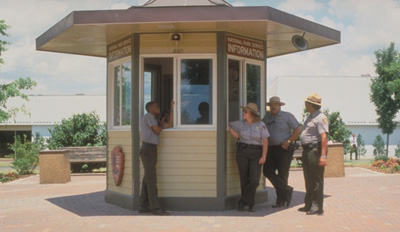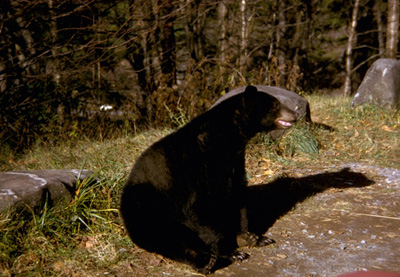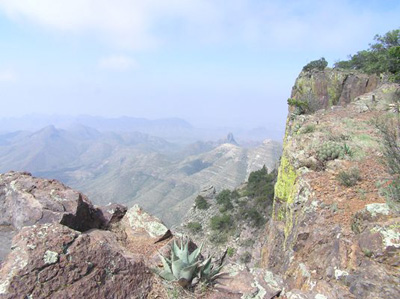
New federal law allows guns in parks
Beginning in February 2010, a new law passed by Congress last spring will allow people to carry guns into national parks and wildlife refuges as long as they are allowed to do so by state law.
Until this new legislation takes effect, gun owners are required to lock and store their guns in a safe place before entering the parks.
The new law has sparked controversy between special interest groups like the National Rifle Association, that believe that the Second Amendment, which guarantees the right of the people to keep and bear arms, should always be upheld and groups like the National Parks Conservation Association interested in protecting the serenity of the national parks.
| The safety of park rangers is a concern now that guns will be allowed in parks. Next, black bear populations are threatened due to illegal poaching. Last, Big Bend National Park waits to see the effect of the law (Photos courtesy of National Park Service). |  |
Despite the controversy between activist groups, the national parks are hesitant to take a position regarding the new legislation.
David Elkowitz, chief of Interpretation for Big Bend National Park in West Texas, said , “We will follow the law, as we uphold the laws of the country.”
Linda Friar, public information officer at Everglades National Park in South Florida, had a similar response.
“We don’t feel one way or the other about the new law. It is a new law and we will comply. We don’t think it will make too much of a difference. It won’t change the way that we approach or deal with people,” she said.
Although officials for the national parks may not be taking a public position on the legislation, they are still concerned with the safety of park visitors and rangers, who are more vulnerable to encountering a dangerous situation now that anyone with a license can carry a concealed weapon around the park.
Kyle Patterson, public information officer for Rocky Mountain National Park in Colorado, said, park rangers have training for situations involving guns and are prepared.
“Our law enforcement rangers are trained to know that anybody that they contact might be carrying a firearm or a weapon, so that will certainly not change. They will understand that the contacts they make might actually have a weapon and it will be legal.”
“We have heard concerns from the volunteers. We have a large volunteer program at Rocky Mountain National Park and they are concerned about the change because they contact a lot of visitors as well and now visitors might have weapons visible or concealed,” Patterson continued.
According to the latest Uniform Crime Report released by the FBI, only 1.65 violent crimes occurred per 100,000 national parks visitors. Compared to the national average of 454.5 violent crimes per 100,000 inhabitants, these numbers are quite low and indicate that national parks are generally a safe haven from violence.
“Some people have expressed that this [carrying concealed weapons] would be a form of protecting them when they come to the park. However, violent crime in Rocky Mountain National Park is extremely rare. We have three million visitors a year and have had very few incidents in the past,” Patterson explained.
 Other parks officials worry that with the new law, the number of violent crimes could rise.
Other parks officials worry that with the new law, the number of violent crimes could rise.
“There is always a concern when there are more guns out there. That is the case with any law enforcement agency,” said Friar.
Another big concern of parks officials is illegal poaching of animals for their resources.
“One of the main reasons the old policy was put in place under the Reagan administration was because of the concern about people poaching animals in national park service sites. If they had a weapon handy they could possibly shoot at wildlife,” Patterson said.
Illegal poachers are responsible for endangering many species that are found within the national parks, such as alligators in the Everglades that are hunted for their hides and black bears whose gallbladders are extremely lucrative in the illegal market.
However, Big Bend National Park’s Elkowitz does not believe that the new law will increase the number of illegal poachers.
“There are no new concerns relating to the gun law. Illegal poaching or the harming of wildlife has always been a concern and I think that will be something we still watch for,” he said.
Aside from the safety of people and wildlife, the parks are also concerned about enforcing gun laws in parks which span across several states.
Yellowstone National Park, which covers parts of Wyoming, Montana and Idaho, and Death Valley National Park, which stretches from California to Nevada, encounter different gun laws as park visitors cross state lines.
Within these parks, people could carry a concealed weapon from a state where the law permits it, to a state where the law does not.
To avoid these issues, parks are doing what they can to make people aware of the new law so that they know where it is acceptable to carry a concealed weapon and where it is not.
“Right now there is a lot of confusion out there because some people thought that the regulation changed immediately as soon as the law was passed and that was not the case, so we have to educate our visitors,” said Patterson.
Elkowitz agreed.
“We are letting visitors know what we know about the new law. They are not allowed to carry a concealed weapon within a federal building or federal office. Before, that was not an issue, so that is a change,” he said.
“We have put up signage and let people know what the new law is so that they know how to follow the law. That is probably the biggest change we have made,” he continued.
Friar had a similar response about the way the Everglades has responded to the law.
“Notifications are on all of our buildings that the new legislation does not allow concealed weapons to be carried into any federal buildings, which would include any visitor’s centers,” she said.
 There is confusion about what actually constitutes a federal building. Aside from visitor’s centers, guns will be banned from administration buildings, museums and ranger stations. However, it is unclear if guns will be forbidden in places like concessionaires as well.
There is confusion about what actually constitutes a federal building. Aside from visitor’s centers, guns will be banned from administration buildings, museums and ranger stations. However, it is unclear if guns will be forbidden in places like concessionaires as well.
Rocky Mountain National Park is taking similar measures to keep visitors informed.
“We have changed some notices on our visitor’s centers and federal buildings indicating that firearms are not allowed in those buildings and that will not change with the new regulations,” Patterson said.
As with any new legislation, Elkowitz said he will have to wait to determine what it means to the parks.
“I can’t tell you [the effect it will have] until I see it,” he stated.
Patterson felt the same saying “only time will tell,” what the new law means for the park.
Until the law is implemented, the national parks will continue to keep people informed about the changes taking place and keep the safety of park visitors their top priority.
“We want to remind people the national parks are a pretty darn safe place to be,” Patterson concluded.

Comments are Closed